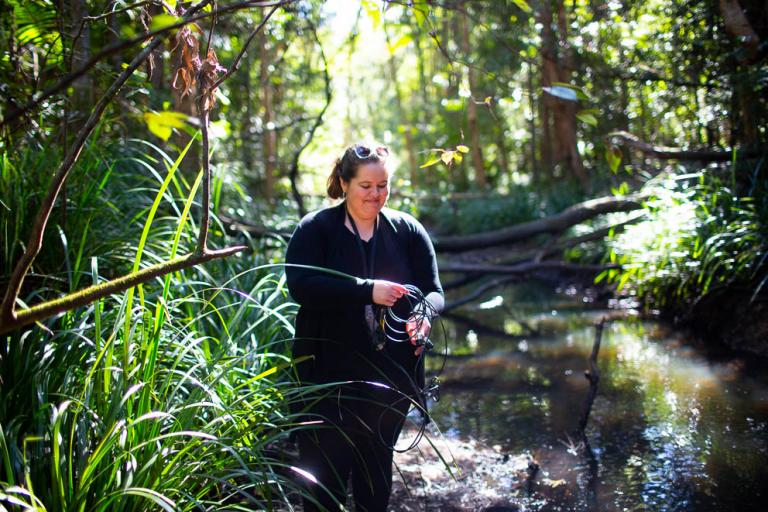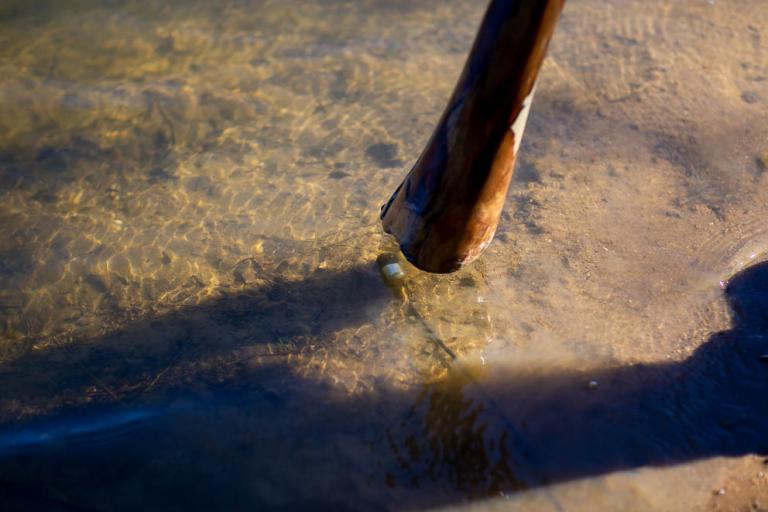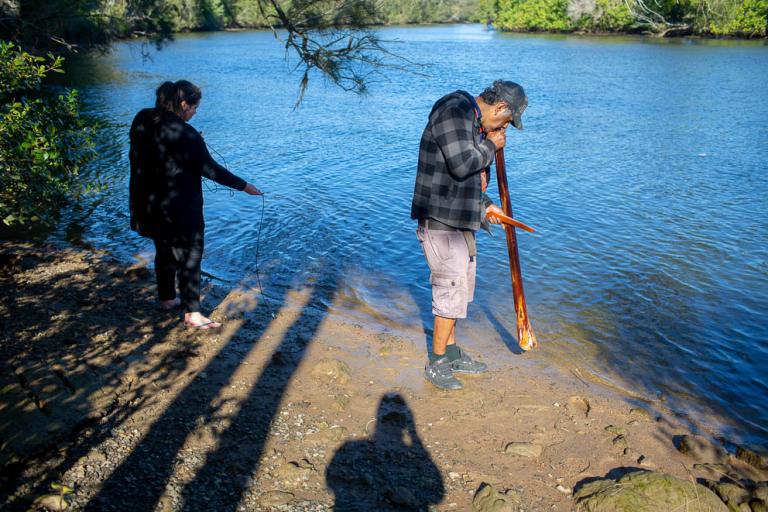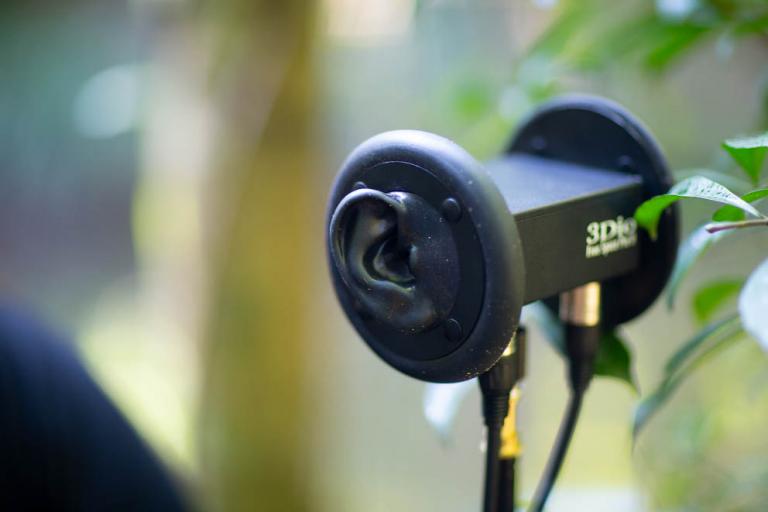Meet Leah Barclay
Who are you and what do you create?
I’m a sound artist, designer and researcher and I create immersive installations, interactive experiences and live performances that are all exploring ways we can use creativity and new technologies to reveal information about the environment and draw attention to changing ecosystems. My practice revolves around sound recordings in the environment and I work at the intersection of art and science, where the soundscapes are used for conservation, scientific research and as source material for these creative experiences to immerse listeners in ecosystems we might not traditionally think about. I strongly believe that listening to the environment is one of the most powerful ways to inspire connection to place and reveal the interconnected nature of our ecosystems.
The work I have created for Horizon Festival in the past has been site-specific with augmented reality sound walks along Cotton Tree or a geodesic surround sound dome on Mooloolaba beach for Listening Underwater, but this year the experience is about remote listening. I’ve created a series of immersive soundscapes exploring environments across the Sunshine Coast that will be produced live and streamed online. The locations include virtual sound walks through Eudlo Creek, an ocean expedition from Mooloolaba out to Old Woman Island and a sonic immersion in the Maroochy River interwoven with Kabi Kabi stories from Lyndon Davis. The soundscapes are deep listening experiences but feature a prelude of site-responsive images by Tricia King to visually engage with the site before listening. I am also using the images as filters and a score for the soundscapes, so it is really an audio-visual dialogue with the site that has been guided by Lyndon’s stories of place.

What materials and techniques do you use?
I am really interested in spatial audio and embodied experiences with sound, so my approach to recording environments is often very intuitive and experimental. The kind of technology I use in these experiences is designed to amplify our aural perception and give access to sounds usually beyond our hearing range. Hydrophones (underwater microphones) are fundamental to my practice and freshwater and marine recordings feature heavily in many of my projects. As an example, during the initial Maroochy River recordings for Listening in the Wild, Lyndon played didgeridoo into the water with the hydrophones immersed in the mangrove mud, so the sounds are resonating through the riverbed and become part of the environment. Those recordings will be mixed live into the soundscapes this Sunday. I also use ultrasonic microphones that can capture recordings above our hearing range that I then transpose into audible materials, and ambisonic and binaural recording that capture the environment the same way we hear it, so it feels very realistic and immersive. I then edit and process these sounds in the studio and sculpt the material into soundscapes that tell a story about that location. I often filter the sound through multiple recordings, so it might be Lyndon’s voice filtered through the riverbed or hydrophone recordings filtered with images of the site, so it becomes a multi-layered approach. Scientific research and live data from the site often inform the techniques I use to create the final works.

What kind of inspirations go into your work?
My work is inspired by the environment and the fact that we rapidly need better ways to inspire urgent action to understand the crisis that is unfolding in ecosystems across the planet. The Paris Agreement came at a time where climate change was undeniably reaching a global tipping point and despite the clear facts and obvious pathways to mitigate the impacts, very little action has been taken globally and public engagement and behavioural change remains a challenge. It is clear that this crisis is not just ecological, but political, social and cultural. Climate change mitigation and adaptation requires interdisciplinary approaches and so much research suggests that the current framing exceeds our cognitive and sensory abilities, making it difficult to comprehend or even take action. Sound has a profound ability to make us feel present and deeply connected to our surrounding environment and I really believe can play a role in connecting us at an empathetic and sensory level, particularly when we are listening to these environments from different perspectives. I feel that engaging in these participatory creative experiences that are designed to inspire empathy, stewardship and action, rather than overwhelming scientific facts, is an effective piece of the puzzle in addressing some of the challenges in communicating climate change and inspiring action.
I'm also inspired by the Rights of Nature movement, rejecting the idea that nature is human property and recognising that the natural world is just as entitled to exist and evolve as we are. As a non-Indigenous artist, I am deeply inspired by my collaborations with First Nations artists. I’ve worked with Lyndon Davis and Brent Miller for over a decade and I learn something new everything we work together. I have always been very inspired by Lyndon’s approach to cultural education – always promoting the idea that everyone is a custodian of the land and we must do everything in our power to protect, conserve and respect the natural world.

In what space do you like to create most?
I guess it goes without saying I like making site-specific work in the environment, I particularly love working with rivers and marine environments. My creative projects are rarely isolated efforts, but part of bigger interdisciplinary research projects. The design of these interdisciplinary projects are responsive to the needs of collaborating communities and involve the development of new technologies including remote sensing devices for the rainforest canopy and hydrophone recording arrays in aquatic ecosystems. The most important part of these projects for me in to be working directly with communities and making sure the creative outcomes and research outputs are impactful and relevant to the community. Collaboration is a big part of everything I do and working in an interdisciplinary context is one of my favourite places to be creating.
Working in virtual environments has always been part of my practice and has become increasingly important (and necessary) during the pandemic. There has been no shortage of research emerging on the value of sound recording and listening to our changing sonic environments during the pandemic. Multiple research projects, many global sound maps and an increased public interest in how our soundscapes have changed. What is problematic with some of these projects is it is often a very colonial recording approach, with edited and manipulated recordings that are being framed as pristine ‘natural environments’ in this very purist way of thinking about nature. I have worked on various virtual collaborative projects during lockdown in this space and I am really interested in the idea of live, unfiltered listening to a remote place pushing back on some of these colonial recording approaches. This is part of the motivation for Listening in the Wild, but I am also very conscious I am editing, processing and mixing the soundscapes – so ultimately interfering with the environment in the way that I am criticising, but my approach is much more about revealing and amplifying parts of the soundscape we can’t usually access, such as tiny micro crustaceans in the river bed or inside the hive of native bees. I am also weaving in recordings from different times of the day and navigating through the ecosystem in a non-linear abstract way. This is part of a series of experiments in creating work for online environments and that place of experimentation, exploration and discovery is absolutely my favourite space to be creating.
What has been your favourite or most important work to date?
This is a hard one – as many of my projects are so interconnected and I have a lot of favourite projects. The River Listening project is definitely close to the top, which is an interdisciplinary project exploring the possibilities of freshwater ecoacoustics in the conservation and management of global river systems. The project works at the intersection of art and science by investigating the cultural and biological diversity of freshwater ecosystems through real-time listening and underwater recording used for biodiversity monitoring and engagement. The creative outcomes from River Listening are central to our public engagement efforts and have included augmented reality applications with soundscapes triggered by GPS along rivers as well as live-streaming hydrophone arrays. These artistic projects have assisted in the advancement of scientific recording techniques and ecoacoustic methods. Some information on the project is available in a recent publication here.
My work with Biosphere Soundscapes in collaboration with UNESCO has also been a highlight, particularly the work we have done through Latin America in Brazil, Peru and Mexico. These recordings are all being used to monitor environmental change but creating large scale interactive installations with my recordings from the Central Amazon Biosphere Reserve has definitely been one of my favourite projects. Mapping the Amazon soundscapes over Times Square for Climate Week NYC and then the Eiffel Tower in Paris for COP21 was a really exciting opportunity to demonstrate the potential of art-science collaborations and the value of sound in connecting decision makers to conservation urgency at a more empathic level.
I’ve been really lucky and privileged to work in some incredible parts of the world, but to be honest these projects have all started on the Sunshine Coast and I really feel like my most important work has been done right here. I’ve looked at the Sunshine Coast as a creative laboratory over the last decade, coming back to make work and then disappearing again. But I moved back to the coast earlier this year to take up a new position at USC in the School of Creative Industries and despite the crisis that has unfolded in 2020, I am really inspired to be back and feel like there are so many exciting connections and collaborations emerging. The Sunshine Coast has an international reputation for ecological engaged creative practice through events such as Floating Land, Treeline and Horizon Festival and I am really looking forward to expanding our programs at USC and incubating a hub for experimental interdisciplinary practice that engages with the environment across the Sunshine Coast.

Join Leah for Listening in the Wild, a project comprised of three separate experiences, streamed live online and also available post event for audiences to access anywhere at any time. The locations include virtual sound walks through Eudlo Creek National Park, a journey along the Maroochy River and an ocean expedition from Mooloolaba Beach. Find out more here.
Images by Tricia King
1. Leah Barclay recording at Eudlo Creek – Listening in the Wild - Image by Tricia King
2. Lyndon Davis playing didjeridoo into the Maroochy River - Listening in the Wild - Image by Tricia King
3. Binaural Microphone - Listening in the Wild – Image by Tricia King
